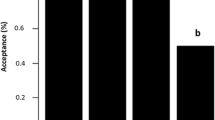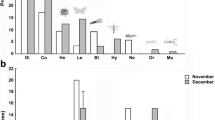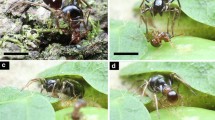Summary
During a 1-year-study in tropical Panama, prey of the social theridiid Anelosimus eximius was analysed at two locations and compared with the potential prey spectrum according to sweepnet catches, pitfall traps and bowl traps. Compared with other web-building spiders, A. eximius catch an unusually high number of large insects: about 90% are flying ants, beetles,lepidopterans hemipterans, cockroaches and grasshoppers. This is the result of a communal strategy to overwhelm prey. Webs are maintained commonly, and several spiders attack an entangled insect simultaneously. More spiders participate on insects that are larger and struggle more. The ability to catch large prey insects is discussed as a major driving factor for sociality in spiders.
Similar content being viewed by others
References
Adis J (1979) Problems of interpreting arthropoc samplings with pitfall traps. Zool Anz (Leipzig) 202:177–184
Brach V (1975) The biology of the social spider Anelosimus eximius (Araneae: Theridiidae). Bull S Calif Acad Sci. 74:37–41
Brach V (1977) Anelosimus studiosus (Araneae: Theridiidae) and the evolution of quasisociality in Theridiid spiders. Evolution 31:154–161
Bradoo B (1972) Some observations on the ecology of social spider Stegodyphus sarasinorum Karsch (Araneae: Eresidae) from India. Orient Insects 6:193–204
Burgess J (1979) Web-signal processing for tolerance and group predation in the social spider Mallos gregalis Simon. Anim Behav 27:157–164
Buskirk R (1981) Sociality in Arachnida. In: Herman H (ed) Social insects. Academic Press, New York
Chauvin R, Denis J (1965) Une araignée sociale du Gabon. Biol Gabonica 1:93–99
Christenson T (1984) Behaviour of colonial and solitary spiders of the theridiid species Anelosimus eximius. Anim Behav 32:725–734
Darchen R (1968) Ethologie d'Achaeranea disparata Denis, Aranea, Theridiidae, araignée sociale du Gabon. Biol Gabonica 4:5–25
Dewar M, Koopowitz H (1970) Behavior of South African social spiders: prey capture. Am Zool 10:476–477
Diguet L (1915) Nouvelles observations sur le mosquéro ou nid d'araignées sociales employé comme piège à mouches dans certaines localités du Méxiques. Bull Soc Acclim Fr 62:240–249
Enders F (1975) The influence of hunting manner on prey size, particularly in spiders with long attack distances (Araneidae, Linyphiidae, and Salticidae). Am Nat 109:737–763
Fischer C (1907) Notes on a social spider, Stegodyphus sarasinorum, Karsch. J Bombay Nat Hist Soc 18:206–207
Ivlev V (1961) Experimental ecology of the feeding of fishes. Yale University Press, New Haven, Conn
Jackson R (1978) Comparative studies of Dictyna and Mallos (Araneae, Dictynidae). I. social organisation and web characteristics. Rev Arachnol 1:133–164
Jackson R (1979) Predatory behavior of the social spider Mallos gregalis: Is it cooperative? Insectes Soc 26:300–312
Jambunathan N (1905) The habits and life history of a social spider (Stegodyphus sarasinorum Karsch). Smithson Misc Collect 47:365–372
Krafft B (1966) Etude du comportement social de l'araignée Agelena consociata Denis. Biol Gabonical 2:235–250
Krafft B (1969) Varlous aspects of the biology of Agelena consociata Denis when bred in the laboratory. Am Zool 9:201–210
Krafft B (1970) Contribution à la biologie et à l'éthologie d'Agelena consociata Denis (Araignée sociale du Gabon). Première partie. Biol Gabonica 6:197–301
Krafft B (1982) The significance and complexity of communication in spiders. In: Witt P, Rovner J (eds) Spider communication. Princeton University Press
Kullmann E (1972) Evolution of social behavior in spiders (Araneae; Eresidae and Theridiidae). Am Zool 12:419–426
Kullmann E, Kloft W (1968) Traceruntersuchungen zur Regurgitationsfütterung bei Spinnen (Araneae, Theridiidae).Zool Anz (Suppl) 32:487–497
Levi H (1956) The spider genera Neottiura and Anelosimus in America (Araneae: Theridiidae). Trans Am Microsc Soc 74:407–422
Levi H (1963) The American spiders of the genus Anelosimus (Araneae, Theridiidae). Trans Am Microsc Soc 82:30–48
Marshall G (1898) Notes on the South African social spiders (Stegodyphus). Zoologist 2:417–422
Nentwig W (1981) The selective prey of linyphiid-like spiders and of their space webs. Oecologia (Berl) 45:236–243
Nentwig W (1982a) Why do only certain insects escape from a spider's web? Oecologia (Berl) 53:412–417
Nentwig W (1982b) Epigeic spiders: Their potential prey and concurrents: Size and frequency relations. Oecologia (Berl) 55:130–136
Nentwig W (1983) The prey of web building spiders compared with feeding experiments (Araneae: Araneidae, Linyphiidae, Pholcidae, Agelenidae). Oecologia (Berl) 56:132–139
Nentwig W (1984) Feeding ecology of the tropical spitting spider Scytodes longipes (Araneae, Scytodidae). Oecologia (Berl) 65:284–288
Nentwig W (1985) Prey analysis of four species of tropical orbweaving spiders (Araneae: Araneidae) and a comparison with araneids of the temperate zone. Oecologia (Berl) (in press)
Nentwig W, Christenson T (1985) Natural history of the nonsolitary sheet-weaving spider Anelosimus jucundus (Araneae: Theridiidae). Zool J Linn Soc (in press)
Pain J (1964) Premières observations sur une éspèce nouvelle d'araignées sociales (Agelena consociata Denis). Biol Gabonica 1:47–58
Riechert S (1978) Energy-based territoriality in populations of the desert spider, Agelenopsis aperta (Gertsch). Symp Zool Soc (Lond) 42:211–222
Shear W (1970) The evolution of social phenomena in spiders. Bull Br Arachnol Soc 1:65–76
Tapia X, Vries T de (1980) Tolerancia y cooperation en la Arana social Anelosimus jucundus del bosque tropical Rio Palenque, Ecuador. Rev Univ Catolica (Quito) 8:51–74
Vollrath F (1982) Colony foundation in a social spider. Z Tierpsychol 60:313–324
Vollrath F, Rohde-Arndt D (1983) Prey capture and feeding in the social spider Anelosimus eximius. Z Tierpsychol 61:334–340
Witt P (1975) The web as a means of communication. Biosci Commun 1:7–23
Author information
Authors and Affiliations
Rights and permissions
About this article
Cite this article
Nentwig, W. Social spiders catch larger prey: a study of Anelosimus eximius (Araneae: Theridiidae). Behav Ecol Sociobiol 17, 79–85 (1985). https://doi.org/10.1007/BF00299433
Received:
Accepted:
Issue Date:
DOI: https://doi.org/10.1007/BF00299433




